Open-air museums
type of museum, in which historical events showing the life in past time periods are performed
An open-air museum is in its broadest sense any exhibition made up of several buildings with a historical theme. These can be historical buildings on site, buildings relocated from other places, or modern replicas.
A living history museum is meant to be a reconstruction of an entire ancient or pre-industrial settlement, or a portion of one.
A pioneer village is a form of living museum in which a village-size group of historic buildings from a New World colony is restored to their use in an earlier time period, usually the time of European settlement (see early United States history and Old West).
Understand
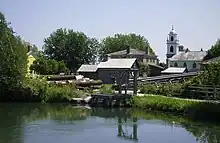
Open-air museums were introduced in the late 19th century, as industrialization and modernization displaced rural folk culture and indigenous cultures. Many nations searched for a common past, and open-air museums became a complement of traditional museum buildings. While indoor museums have traditionally displayed the culture of institutions such as monarchies, religious authorities and the urban elite, open-air museums are more often a showcase of commoners of the countryside; though there are always exceptions for both cases.
The nominal time periods reflected in living history museums can be wide, with some museums reflecting periods as late as the mid 20th century. Often, the village (or the group of buildings) is assembled from authentic local historic buildings which are relocated to a common site as a means of historic preservation; this may preserve structures which otherwise would be lost due to urban development or population loss, or destroyed by flooding after construction of a hydroelectric dam. Wooden buildings are relatively easy to dismantle and relocate.
A living museum may not recreate an entire village or settlement; in some cases just one or a handful of buildings are restored to operation, anything from an individual mill or blacksmith shop to a historic fortress. Confusingly, the term "living museum" is also often applied to nature museums or protected areas, which are not the same concept.
The target eras for pioneer villages vary, with the "pioneer era" – widespread global colonisation by Europeans in the 1600s and 1700s, ending with adoption of steam power in the Victorian 1800s – among the most popular. Native or Viking settlements are also occasional targets for reconstruction, as a village may represent any era before the adoption of 20th century automation, industrialisation and mechanisation. The term "pioneer village" is colonial in origins and context.
By its nature, the list below is not comprehensive.
See
Living history museums typically have museum guide staff in period costume carrying out the tasks of tradespeople of that era with traditional methods and tools, including or similar to historical re-enactment.
An open-air museum can be combined with a zoo, usually for local breeds of livestock and local wildlife, or have horse riding, period livestock, dogs and cats integrated with the living history village or farm itself. They can also have agritourism, such as traditional vegetable farming and food processing. If the target period is the Industrial Revolution of the 18th to 20th century, historical machinery and manufacturing methods (including steam power) can be on display. See Industrial tourism.
Some open-air museums can include, or be near, more recreational facilities such as an amusement park.
Australia

- 🌍 Burnie Regional Museum (Burnie (Tasmania)). It covers the local economic boom period from 1890-1910. (updated Dec 2022)
- 🌍 Sovereign Hill (Ballarat, Victoria). 1851 gold rush town with sixty historically recreated buildings, costumed staff and volunteers.
- 🌍 Timbertown Pioneer Village (on Oxley Highway, Wauchope (New South Wales)). Very good old timber town of the 1880s set on 87 acres (35 hectares).
Belgium
- 🌍 Bokrijk (Genk). Largest living history museum in Flanders, with 148 authentic buildings and a collection of 30,000 historic items in the museum. It mainly focusses on rural life from the 17th century up to the 1950s, with the oldest building dating back to 1507. Threatened historic buildings from all over Flanders were carefully deconstructed and moved to Bokrijk throughout the second half of the 20th century, which now features entire villages consisting of farms, inns, a school, a church, and various craftsmen workshops. (updated Dec 2022)
Canada
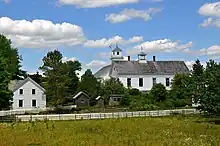
From west to east:
- 🌍 Dawson City (Yukon). A historic Klondike gold rush town preserved as a National Historic Site, but it's also a thriving, working community. (updated Dec 2022)
- 🌍 Barkerville Historic Town and Park (Barkerville (British Columbia)). 1860s restored gold rush boom town with a streetscape of more than 125 heritage buildings, authentic displays, satellite museums, restaurants, shops and accommodations. (updated Jun 2020)
- 🌍 Walter Wright Pioneer Village (Dawson Creek (British Columbia)). This historic village portrays a theme depicting Dawson Creek before the Alaska Highway construction period. (updated Jun 2018)
- 🌍 Bar U Ranch (near Longview (Alberta)). Ranging life during the time period 1882-1950.
- 🌍 Fort Edmonton Park (Edmonton (Alberta)). A reconstruction of 1830s fur trade post plus dozens of original and replica buildings relocated to themed zones: 1885 Street, 1905 Street, and 1920 Street. (updated Sep 2019)
- 🌍 Heritage Park (Calgary (Alberta)). One of the largest living historical villages in North America, on 66 acres of land near the Glenmore Reservoir. (updated Jun 2020)
- 🌍 Ukrainian Cultural Heritage Village (Село спадщини української культури) (on eastern edge of Elk Island National Park (Alberta)). shows the lives of Ukrainian Canadian settlers from 1899 to 1930. (updated Sep 2019)
- 🌍 Batoche National Historic Site (near Rosthern (Saskatchewan)). Métis settlement and site of the last decisive battle of the Rebellion/Resistance of 1885. (updated Sep 2019)
- 🌍 Pioneer Village Museum (Beausejour (Manitoba)). It includes a log house, schoolhouse, community hall, Canadian Pacific Railway station, store, blacksmith shop, and a Ukrainian Church with a bell tower. (updated Dec 2022)
- 🌍 Black Creek Pioneer Village, Toronto/North York (Ontario). An example of a typical crossroads community found in the Toronto area during the 1800s. 40 carefully restored heritage homes, shops & gardens. (updated Dec 2017)
- 🌍 Doon Heritage Village (Kitchener (Ontario)). 22 buildings recreate life in rural Waterloo County in 1914. (updated Dec 2022)
- 🌍 Fanshawe Pioneer Village (London (Ontario)). It tells the story of rural communities from 1820 to 1920.
- 🌍 Fort George National Historic Site (Niagara-on-the-Lake (Ontario)). A reconstructed British fort and living museum which featured prominently in the War of 1812. (updated Sep 2019)
- 🌍 Fort Henry National Historic Site (Kingston (Ontario)). 1850s stone fortress with cannons defends access to the Rideau Canal from US attacks; the fort is guarded by Fort Henry Guard in British uniforms and regalia of the era. Live military drills. (updated Sep 2019)
- 🌍 Fort Malden National Historic Site (Amherstburg (Ontario)). The buildings on the complex represent different time periods of its history since 1795. (updated Sep 2019)
- 🌍 Kawartha Settlers Village (Bobcaygeon (Ontario)). A collection of over 20 historic homes and buildings from 1830 – 1935. (updated Jul 2017)
- 🌍 Lang Pioneer Village (near Peterborough (Ontario)). More than 20 heritage and reconstructed buildings from the 1800s. (updated Oct 2016)
- 🌍 Old Fort Erie (Fort Erie (Ontario)). A fort restored to the 1812-1814 period (War of 1812). (updated Sep 2019)
- 🌍 Pickering Museum Village (near Pickering (Ontario)). Depicts live pioneers in 18 heritage buildings.
- 🌍 Sainte-Marie among the Hurons (Midland (Ontario)). Reconstructed Jesuit mission settlement.
- 🌍 Upper Canada Village (Morrisburg (Ontario)). Pioneer 1860s village of thirty buildings staffed by skilled re-enactors in costume of the era.
- 🌍 Scarborough Historic Museum (Toronto/Scarborough (Ontario)). Settler village of four heritage buildings. (updated Dec 2022)
- 🌍 Le Village Québécois d'Antan (Drummondville (Québec)). A re-creation of village life in the 19th century. Includes an old farm, period costumes, a restaurant and several festivals throughout the year.
- 🌍 Village Historique Acadien (near Caraquet (New Brunswick).). Depicts an Acadian community between 1770 and 1939.
- 🌍 King's Landing (near Fredericton (New Brunswick)). United Empire Loyalist village.
- 🌍 Sherbrooke Village (Sherbrooke (Nova Scotia)). It depicts life in the later 1800s in the wake of the gold rush era. (updated Dec 2022)
- 🌍 Fortress of Louisbourg (Louisbourg (Nova Scotia)). Village-sized historic French military settlement, destroyed after English conquest and later reconstructed.
- 🌍 L'Anse aux Meadows (Great Northern Peninsula (Newfoundland and Labrador)). Archaeological site with reconstructions of a Norse settlement dating to approximately 1,000 years ago.
Czech Republic
- 🌍 Polabské muzeum Poděbrady, Skanzen 19, 289 16 (Přerov nad Labem). Almost forty examples of folk architecture on an area of two hectares: nine cottages, seven storehouses, four barns, a chapel, and other small folk buildings. (updated Dec 2022)
Estonia
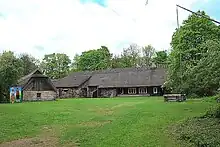
- 🌍 Eesti Vabaõhumuuseum (Estonian Open Air Museum) (Tallinn). A reconstruction of 18th century rural village with church, schoolhouse, mill, farm houses, windmill, general grocery store and walking trails. (updated Oct 2021)
- 🌍 Muhu Museum (Koguva, Muhu). Traditional village in the Muhu island, with open-air museum.
France
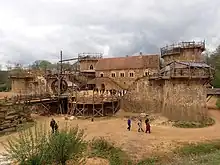
- 🌍 Guédelon Castle (Château de Guédelon) (near Auxerre). An archaeological experiment to recreate a 13th-century castle started in 1997, it is being built using only tools, materials, and techniques known in medieval France in that era. All handling, transport, and masonry work is completed with manual labour. Construction is expected to be completed in 2029. The construction site is open to the public. (updated Dec 2022)
Germany
In Germany museums of this kind are often called "Freilandmuseum" (Literally: "open air museum") and may constitute of buildings that were disassembled carefully at their original location and then reassembled at the museum site.
- 🌍 Black Forest Open Air Museum (Black Forest). Centred on a farmhouse built on site in the traditional architectural style of the area in 1612, the museum has many relocated structures, and showcases the regional artizanship and livelihood.
- 🌍 Fränkisches Freilandmuseum Bad Windsheim (Bad Windsheim).
- 🌍 Freilichtmuseum auf der Insel (Stade).
- 🌍 Ukranenland (near Neubrandenburg). A museum depicting what Slavs living in the area may have lived like.
Japan
- 🌍 Boso No Mura (千葉県立房総のむら chiba-kenritsu bōsō no mura), Narita. A reproduction of a samurai-era Japanese town street and samurai residence.
- 🌍 Hida Folk Village (飛騨民俗村 'Hida Minzokumura' also known as Hida-no-Sato (飛騨の里)) (Takayama). An attractive open-air museum assembled from real buildings that effectively recreates an entire traditional mountain village. Artisans continue to work in many buildings; you can buy their crafts and even try your own hand at a number of activities.
- 🌍 Hokkaido Pioneer Village (北海道開拓の村) (on the outskirts of Sapporo). A series of alleys and buildings of the style pre-20th century. Also a variety of different gardens and shrines.
Malaysia
- 🌍 Kampung Budaya Sarawak (Sarawak Cultural Village) (Kuching, Sarawak). A living museum where you can experience the local culture and lifestyles of the various ethnic groups in Sarawak. (updated Dec 2022)
Netherlands

- 🌍 Bourtange. A town built entirely inside of a 16th-century pentagonal fort, which was fully restored in the 1960s to its state in the 1740s.
- 🌍 Nederlands Openluchtmuseum (Arnhem). A 44-hectare museum that sets out to document the Netherlands' history.
- 🌍 Groenlo (Oost Gelre). A bi-annual reenactment of the 1627 Siege of Grolle (Groenlo).
- 🌍 Archeon (Alphen aan den Rijn). Open-air and archaeological museum focussing on the early Dutch history (during Prehistory, the Roman and Medieval age). (updated Oct 2021)
- 🌍 Dickens Festijn (Deventer). Annual event in Deventer centring around the characters of Charles Dickens. The event is often combined with Christmas activities. The entire Bergkwartier, one of the oldest parts of Deventer, is transformed into a Victorian-era style, with re-enactors roaming the streets, attracting around 120,000 visitors each year. (updated Oct 2021)
- 🌍 Historical Festival Almelo (Almelo). Re-enactment event of the French age (1795 - 1815) in Almelo, specifically focussing on the Battle for Ruigerode, a fictional battle in Napoleontic style. The event has about 700 re-enactors, and attracts several tens of thousands of visitors. (updated Oct 2021)
- 🌍 Gebroeders van Lymborchfestival (Nijmegen). Medieval music and theatre festival in Nijmegen, in which around 700 re-enactors roam the streets of the city centre, displaying the daily life in the Duchy of Guelders from 1350-1450. Highlight is the "Blijde Incomste" (Delighted Entrance) on the Sunday afternoon, in which the landvoogd (Advocatus) enters a town or city in a large parade of festivities. (updated Oct 2021)
- 🌍 Openluchtmuseum Eynderhoof (Nederweert-Eind). Open-air museum which aims to relive the daily life in the Peel Region around 1900, featuring around a dozen houses and workplaces. (updated Oct 2021)
New Zealand
- 🌍 Taranaki Pioneer Village (Stratford). A 10-acre village with 40 buildings dating back to 1853 and a steam train. (updated Nov 2021)
- 🌍 Founders Park (Nelson). A collection of historic buildings that were re-located from sites in Nelson, many with interior mini-museums or historical displays. There is an organic brewery with an attached cafe that serves good meals. There is also a craft bakery, a chocolate shop, and a railway that runs on weekends. (updated Dec 2016)
- 🌍 Howick Historical Village (South Auckland). This historical park gives visitors a taste of what life was like from 1840 to 1880. (updated Dec 2018)
Nordic countries
The Nordic countries have been forerunners in the creation of open-air museums to preserve Nordic folk culture, including minorities such as the Sami culture. As many Nordic buildings were made of wood, relocation has been rather easy. Some open-air museums also commemorate the Vikings and the Old Norse and other periods of Nordic history.
Denmark
- 🌍 The Medieval Center (Middelaldercentret) (Nykøbing Falster). It depicts the middle ages in the Denmark of the late 14th and early 15th centuries.
Finland
- 🌍 Kuralan kylämäki (Turku). A village of a few farms, telling about countryside life in the 1950s. Period toys and playing equipment. Livestock. Experimental archaeology workshop and related activities.
- 🌍 Luostarivuori Handicraft Museum (Klosterbacken) (Turku). An open-air museum in a former poor residential area, which survived the great fire of 1827. A few of the houses are furnished according to the history of the specific house, while others host period handicraft workshops and dwellings not in that area at the time of the fire. Artisans knowing a period craft get to use the workshops while agreeing to act as guides on it. Guides and other personnel dress in period clothes.
- 🌍 Seurasaari (Fölisön) (Helsinki). An island with houses collected from all over the country. In summer many buildings have museum staff who practice crafts in traditional dress.
- 🌍 Siida (Inari). The Finnish Sámi museum. Outside the museum building is a 7 ha open-air museum including also an archaeologic site.
Norway
- 🌍 Norsk Folkemuseum (Oslo). Founded in 1894 and built in parallel with Skansen in Stockholm, during the Swedish-Norwegian union. Contains several indoor exhibition as well as farms from most Norwegian provinces.
- 🌍 Guovdageainnu gilišillju (Kautokeino bygdetun) (Kautokeino). Museum for Sámi arts, culture and history, including an open-air museum.
Sweden
- 🌍 Skansen (Stockholm/Djurgården). Founded in 1891, Skansen is the world's oldest open-air museum, containing a zoological garden specializing in Nordic fauna, such as moose, reindeer, bear, wolf, lynx and wolverine. It features over 150 historic buildings from previous centuries, from all parts of Sweden. Guides in historic costumes further enhance this attraction, and demonstrate domestic crafts such as weaving, spinning, and glass blowing. The Skansen area is fairly large (700 metres across) with steep slopes and limited public transport (there is a funicular and an escalator to the upper area) so be prepared for long walks.
- 🌍 Gamla Linköping and Valla fritidsområde (Old Linköping), Tunnbindaregatan 1 (Linköping). Beautiful buildings once in the centre of Linköping have been saved from demolishion and moved to this area to make its own little town. Here you can practically enjoy life of Linköping in the 19th century. The citizens of Linköping enjoy taking part of the life and you can see people actually dressed up and working as citizens of Gamla Linköping. Also remember to buy locally produced chocolate and candy to reduced prices. In total the areas have some 20 museums.
- 🌍 Foteviken Museum, Höllviken, in Vellinge municipality near Malmö. An open-air Viking museum centred around a large Viking settlement reconstruction.
- 🌍 Bungemuseet (Northern Gotland). Open air museum with many old buildings.
Romania
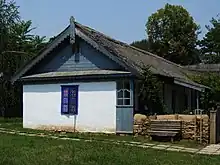
- 🌍 Village Museum (Muzeul Național al Satului „Dimitrie Gusti”) (Bucharest). An open air museum created in 1934, it now has around 300 traditional buildings (including churches, workshops, mills) and furniture, pottery, clothing gathered from villages in every region of the country in an effort to showcase the traditional way of life of the Romanians. Occasionally hosts folkloric and traditional crafts festivals. (updated Sep 2018)
Russia
South Africa
- 🌍 Pilgrim's Rest (Mpumalanga). A partially-restored 1873 gold rush town that is a living museum for that period. (updated Dec 2022)
- 🌍 Worchester Museum (Western Cape). A cultural history museum with a focus on agriculture. The grounds have structures forming a traditional Cape farm yard. Live demonstrations depict activities such as baking bread in an outdoor brick oven and forging metal by a blacksmith. (updated Mar 2021)
South Korea
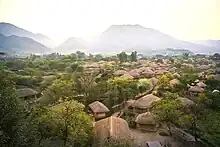
- 🌍 Seonbichon Village (선비촌) (Yeongju). This is where the cultural heritage of Korea’s classical scholars is preserved. It offers a variety of traditional activities for visitors. Traditional dining is available at Jeojatgeori Street. You can stay overnight in a traditional hanok house. (updated Dec 2022)
Spain
- 🌍 Museu Etnogràfic d'Eivissa – Can Ros (Santa Eulària des Riu, Ibiza). A mountaintop village museum specializing in local material culture, that displays the characteristic elements of the house and the daily objects of peasant and artisan life. (updated Dec 2022)
- 🌍 Poble Espanyol (Barcelona). A "typical Spanish village" built for the 1929 World's Fair in Barcelona that consists of 117 full-scale buildings replicated from different places in the Iberian Peninsula, joined forming a small town recreating urban atmospheres of disparate places in Spain.
Turkey
- 🌍 Altınköy Open Air Museum (Ankara). A reconstruction of the 1930s-50s Anatolian village life.
- 🌍 Göreme Open Air Museum (Göreme, Cappadocia). The museum has a collection of caves and fairy chimneys. The museum is a succession of underground churches, some with simple geometric motifs, and others with wonderful frescoes from the 11th and 12th centuries. (updated Jan 2022)
Ukraine
- 🌍 Open-Air Museum of Folk Architecture and Rural Life (near Kyiv). 19th-century Ukrainian life is depicted in six restored rural villages with old huts, wooden mills and churches from all over Ukraine. Description is primarily Ukrainian-language, although some guided tours in other languages are available.
United Kingdom
The UK has a number of open-air museums, a number of which have 'living history' elements. Not all the museums listed here have re-enactors.

- 🌍 Auchindrain Museum (6 miles south of Inveraray). Skansen-type recreation of a farming township circa 1800, on a 22 acre site.
- 🌍 Cosmeston Medieval Village (near Lavernock in the Vale of Glamorgan (Wales)). Re-creation of 14th-century peasant life in the Late Middle Ages, groups of re-enactors camp in tents around the village outskirts and perform historical combat displays. (updated Jun 2018)
- 🌍 Living History Village of Little Woodham (on the Gosport peninsula, Hampshire). Seventeenth century village on ancient woodland in Rowner. Gosport Living History Society villagers dress in costume to talk about Charles I, the impending war between the King and Parliament, their village life and day-to-day existence as if it were the summer of 1642.
- 🌍 Highland Folk Museum (Newtonmore, near Kingussie). Open air museum of ordinary highland life.
- 🌍 Ulster American Folk Park, Castletown, County Tyrone (near Omagh, Northern Ireland). Historical lifestyle and experiences of immigrants who sailed from Ulster to America in the 18th and 19th centuries. 30 buildings, agricultural displays and animals, samples of local foods such as smoked salmon and bread, volunteers in period costume demonstrate bread making, cooking, arts and crafts, embroidery, spinning and printing. (updated Dec 2016)
- 🌍 Skye Museum of Rural Life (Kilmuir, by Portree, Isle of Skye). A semi-recreation of a pre-modern Highland village, consisting of single storey cottages and crofts. (updated Jun 2018)
Later periods (19th century)
- See also: Industrial Britain
- 🌍 Beamish Open Air Museum (Beamish, County Durham). Excellent industrial museum, recreating life in the area during the 19th and early 20th century. (updated Jul 2018)
- 🌍 Black Country Living Museum (Dudley, West Midlands). Outdoor recreation of the local area on 26 acres (11 hectares), including a coal mine, canal port and rebuilt houses.
- 🌍 Blists Hill Museum (near Telford, Shropshire). A living history museum and reconstructed Victorian town.
United States of America
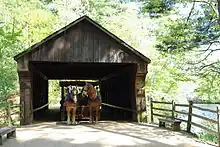
- 🌍 Caesar's Creek Pioneer Village (Waynesville (Ohio)). 19 original Quaker buildings from the 1700s and early 1800s.
- 🌍 Colonial Williamsburg. Historic area re-creates 18th-century Williamsburg (Virginia) before and during the American Revolution.
- 🌍 Divide County Museum and Pioneer Village, Crosby (North Dakota). 25 pioneer buildings including a bank, printing press, general store and dwelling shacks.
- 🌍 Harold Warp Pioneer Village (Minden (Nebraska)). 28 buildings on 12 acres (4.9 hectares), with 12 of those around a green (updated Nov 2018)
- 🌍 Mitchell Prehistoric Indian Village (Mitchell (South Dakota)). An archeological site with reconstructed native lodge.
- 🌍 Old Sturbridge Village (Sturbridge (Massachusetts)). Re-creates life in rural New England during the 1830s.
- 🌍 Pioneer Village (Salem (Massachusetts)). A 3 acres (1.2 hectares) re-creation of a Puritan village. (updated Dec 2022)
- 🌍 Prairie Village (Madison (South Dakota)). Over 40 antique-filled buildings, including Lawrence Welk Opera House, sod and log houses, a country school, churches, one of the last remaining chapel roadcars and agricultural displays. Surrounded by two miles of railroad track. Or take a ride on one of the last remaining steam-powered carousels.
- 🌍 Bonanzaville, USA, 1351 Main Avenue W (West Fargo, North Dakota). 36 buildings providing an insight into the earliest settlers, how they lived, what they possessed and the challenges they faced. (updated Dec 2022)
- 🌍 Plimoth Patuxet (formerly Plimoth Plantation) (Plymouth). A historical farm and living history museum renowned among academic historians and history-recreation buffs alike. Includes a 1627 living history reenactment of early colonial life where visitors can roam the village, enter the homes, and interact with colonists who stay in character. There is also a recreation of a Wampanoag homesite of the period staffed with interpreters who trace their ancestry to Native tribes, and a 17th century craft center where clothing, candles, pottery, and other items are made by hand.
- 🌍 Hancock Shaker Village (Pittsfield). This Shaker site is in remarkable shape, and features a unique round stone barn. It now encompasses about 1,200 acres and 20 restored buildings. See also Touring Shaker country.